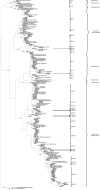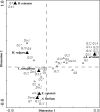Host preferences of arbuscular mycorrhizal fungi colonizing annual herbaceous plant species in semiarid Mediterranean prairies
- PMID: 22752164
- PMCID: PMC3416610
- DOI: 10.1128/AEM.01287-12
Host preferences of arbuscular mycorrhizal fungi colonizing annual herbaceous plant species in semiarid Mediterranean prairies
Abstract
In this study, we have analyzed and compared the diversities of the arbuscular mycorrhizal fungi (AMF) colonizing the roots of five annual herbaceous species (Hieracium vulgare, Stipa capensis, Anagallis arvensis, Carduus tenuiflorus, and Avena barbata) and a perennial herbaceous species (Brachypodium retusum). Our goal was to determine the differences in the communities of the AMF among these six plant species belonging to different families, using B. retusum as a reference. The AMF small-subunit rRNA genes (SSU) were subjected to nested PCR, cloning, sequencing, and phylogenetic analysis. Thirty-six AMF phylotypes, belonging to Glomus group A, Glomus group B, Diversispora, Paraglomus, and Ambispora, were identified. Five sequence groups identified in this study clustered to known glomalean species or isolates: group Glomus G27 to Glomus intraradices, group Glomus G19 to Glomus iranicum, group Glomus G10 to Glomus mosseae, group Glomus G1 to Glomus lamellosum/etunicatum/luteum, and group Ambispora 1 to Ambispora fennica. The six plant species studied hosted different AMF communities. A certain trend of AMF specificity was observed when grouping plant species by taxonomic families, highlighting the importance of protecting and even promoting the native annual vegetation in order to maintain the biodiversity and productivity of these extreme ecosystems.
Figures




References
-
- Alguacil MM, Roldán A, Torres MP. 2009. Assessing the diversity of AM fungi in arid gypsophilous plant communities. Environ. Microbiol. 11: 2649–2659 - PubMed
-
- Alguacil MM, Roldán A, Torres MP. 2009. Complexity of semiarid gypsophilous shrub communities mediates the AMF biodiversity at the plant species level. Microb. Ecol. 57: 718–727 - PubMed
-
- Alguacil MM, Lozano Z, Campoy M, Roldán A. 2010. Phosphorus fertilisation management modifies the biodiversity of AM fungi in a tropical savanna forage system. Soil Biol. Biochem. 42: 1114–1122
-
- Alguacil MM, et al. 2011. The application of an organic amendment modifies the arbuscular mycorrhizal fungal communities colonizing native seedlings grown in a heavy-metal-polluted soil. Soil Biol. Biochem. 43: 1498–1508
-
- Alguacil MM, Torres MP, Torrecillas E, Díaz G, Roldán A. 2011. Plant type differently promote the arbuscular mycorrhizal fungi biodiversity in the rhizosphere after revegetation of a degraded, semiarid land. Soil Biol. Biochem. 43: 167–173
Publication types
MeSH terms
Substances
Associated data
- Actions
- Actions
- Actions
- Actions
- Actions
- Actions
- Actions
- Actions
- Actions
- Actions
- Actions
- Actions
- Actions
- Actions
- Actions
- Actions
- Actions
- Actions
- Actions
- Actions
- Actions
- Actions
- Actions
- Actions
- Actions
- Actions
- Actions
- Actions
- Actions
- Actions
- Actions
- Actions
- Actions
- Actions
- Actions
- Actions
- Actions
- Actions
- Actions
- Actions
- Actions
- Actions
- Actions
- Actions
- Actions
- Actions
- Actions
- Actions
- Actions
- Actions
- Actions
- Actions
- Actions
- Actions
- Actions
- Actions
- Actions
- Actions
- Actions
- Actions
- Actions
- Actions
- Actions
- Actions
- Actions
- Actions
- Actions
- Actions
- Actions
- Actions
- Actions
- Actions
- Actions
- Actions
- Actions
- Actions
- Actions
- Actions
- Actions
- Actions
- Actions
- Actions
- Actions
- Actions
- Actions
- Actions
- Actions
- Actions
- Actions
- Actions
- Actions
- Actions
- Actions
- Actions
- Actions
- Actions
- Actions
- Actions
- Actions
- Actions
- Actions
- Actions
- Actions
- Actions
- Actions
- Actions
- Actions
- Actions
- Actions
- Actions
- Actions
- Actions
- Actions
- Actions
- Actions
- Actions
- Actions
- Actions
- Actions
- Actions
- Actions
- Actions
- Actions
- Actions
- Actions
- Actions
- Actions
- Actions
- Actions
- Actions
- Actions
- Actions
- Actions
- Actions
- Actions
- Actions
- Actions
- Actions
LinkOut - more resources
Full Text Sources
Molecular Biology Databases

